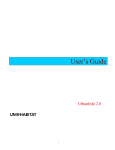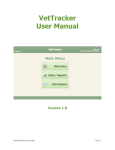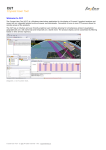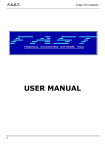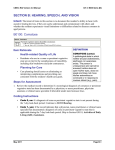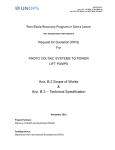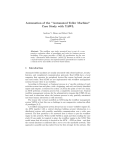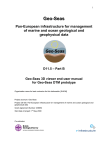Download pdf manual - CARICOM Statistics
Transcript
User’s Guide 1 Acknowledgement This database software has been developed with the cooperation of the UN system. The product has been adapted from UNICEF ChildInfo technology. 2 Contents INTRODUCTION ...................................................................................................................... 7 C H A P T E R ............................................................................................................................ 5 1 ........................................................................................................................................... 5 GETTING STARTED ................................................................................................................................................. 5 System Requirements................................................................................................................................................ 6 Installing CARICOMINFO 1.0 .................................................................................................................................... 6 CHAPTER 2 ................................................................................................................................................... 7 THE HOMEPAGE ...................................................................................................................................................... 7 Making a Selection ....................................................................................................................................................... 9 Deleting a Selection .................................................................................................................................................... 10 CHAPTER 3 ................................................................................................................................................. 11 SELECTING DATA PARAMETERS .............................................................................................................................. 12 Selecting Indicators ...................................................................................................................................................... 12 Selecting Time ............................................................................................................................................................... 13 Selecting Areas ............................................................................................................................................................. 14 CHAPTER 4 ................................................................................................................................................. 16 VIEWING DATA ....................................................................................................................................................... 17 Data View....................................................................................................................................................... 17 Viewing Statistics......................................................................................................................................................... 18 Viewing Sources .......................................................................................................................................................... 19 Viewing Units .............................................................................................................................................................. 20 Viewing Subgroups ...................................................................................................................................................... 21 Sorting Data ................................................................................................................................................................ 22 3 CHAPTER 5 .................................................................................................................................................. 2 PRESENTATION WIZARDS ............................................................................................... 24 CREATING TABLES ................................................................................................................................................. 25 STEP 1 - Selecting Rows and Columns ...................................................................................................................... 25 STEP 2 - Entering Table Options ................................................................................................................................ 26 STEP 3 - Preview Table .............................................................................................................................................. 28 STEP 4 - Saving the Table ......................................................................................................................................... 29 CREATING GRAPHS ................................................................................................................................................ 31 STEP 1 - Selecting X and Y Axis ................................................................................................................................ 31 STEP 2 - Sorting the Data .......................................................................................................................................... 31 STEP 3 - Preview the Graph ....................................................................................................................................... 31 STEP 4 - Saving the Graph ........................................................................................................................................ 32 CREATING MAPS .................................................................................................................................................... 33 STEP 1 - Selecting the Map Theme ........................................................................................................................... 33 STEP 2 - Selecting Map Options. ............................................................................................................................... 35 STEP 3 - Customizing the Map ................................................................................................................................... 36 STEP 4 - Preview the Map .......................................................................................................................................... 37 STEP 5 - Saving the Map ........................................................................................................................................... 37 CHAPTER 6 .............................................................................................................................................. 72 GALLERY VIEW OBJECTS IN GALLERY .......................................................................................................................... 73 CREATE POWERPOINT PRESENTATION .......................................................................................................... 74 CHAPTER 7 ................................................................................................................................................. 75 REPORTS CREATING REPORTS ..................................................................................................................................... 75 4 CHAPTER 8 ................................................................................................................................................. 75 CALCULATE .........................................................................................................................................78 PERCENT ..................................................................................................................................................... 79 100 MINUS ................................................................................................................................................... 85 COMPOSITE INDEX ........................................................................................................................................ 89 SUBTOTAL .................................................................................................................................................... 95 TRANSFORM UNIT ....................................................................................................................................... 100 USER-DEFINED FORMULA ........................................................................................................................... 106 APPENDIX ...........................................................................................................................................111 MENU BAR OPTIONS ............................................................................................................................................ 111 File Menu ....................................................................................................................................................... 111 Open ......................................................................................................................................................................... 111 Database Summary Report ...................................................................................................................................... 111 User Preferences ...................................................................................................................................................... 113 Exit ............................................................................................................................................................................ 118 Help Menu ...................................................................................................................................................... 118 Support ..................................................................................................................................................................... 118 INDEX ..................................................................................................................................................120 5 Introduction CARICOMINFO 1.0 is an adaptation of DevInfo (DI) 5.0. DevInfo (DI) 5.0 is an advanced database management system to keep track of the commitments towards human development. It is endorsed by the UN to report on the progress towards the Millennium Goals. With DevInfo, you are literally a few mouse clicks away from facts that help you to: • Analyze data for evidence-based decision making. • Undertake results-based monitoring and evaluation. • Link different levels—national, sub national and regional—of planning. • Reach out to a large and diverse audience through thematic advocacy. The introduction gives a preview of: 1. Features of CARICOMINFO 1.0 2. Content Overview 3. User Interface 1. Features of CARICOMINFO 1.0 The features of the software give you a lot of options in querying for data and help to undertake results-based monitoring and effective advocacy. These features include: • User friendly interface for hassle • Online data access and query. • Grouping bar in data view to better organize and analyze data. • Enhanced Table wizard features: Aggregate function, more options for cross tabulation. • Enhanced Map Wizard features: Options for Dot density and chart theme, label nudging, inset and exporting to raster image. • Reports feature to store report templates and apply ready-to-use report formats across databases. 6 2. Content Overview This guide contains eight chapters, an appendix and an index. It provides a step-by-step explanation for querying data and generating reports. Key steps have been graphically illustrated to help you better understand CARICOMINFO 1.0 and effectively use it in achieving your work objectives. Chapter 1, “Getting Started” outlines the systems requirements and installation procedure. Chapter 2, “The Homepage” introduces the opening page of CARICOMINFO 1.0 and tells you about different ways of accessing data. Chapter 3, “Searching Data” explains the steps in querying data using key parameters: Indicator, Time and Area. Chapter 4, “Viewing Data” introduces options to customize the Data view. You can learn to use statistical options and get more information from the data view. Chapter 5, “Presenting Data” explains the steps in creating professional output using wizards: Table, Graph and Map. Here you can learn to use advanced wizard options. Chapter 6, “Gallery” takes you through the steps in viewing tables, graphs and maps in the gallery. Learn to create a PowerPoint presentation in the Gallery wizard. Chapter 7, “Reports” outlines the steps in applying report templates to different databases. Chapter 8, “Calculate” takes you through the steps in using the utilities in the Calculate wizard. “Appendix 1” explains the menu bar options in the home page of CARICOMINFO 1.0. 7 3. User Interface The CARICOMINFO 1.0 Interface different tool bars and buttons to help you intuitively navigate the application. A typical interface includes following elements: Fig. 1 Interface elements Title bar: Displays application name followed by the name of the database in use. Menu bar: Displays Menu options: File, Menu, and Help. Each of those options is explained in Appendix 1. Navigation bar: Displays the page tabs in CARICOMINFO 1.0. There are six tabs in the navigation bar: Indicator, Time, Area, Data, Gallery, and Reports. Click on a tab to display the corresponding page. You can move to a desired page at any point of time by clicking on the respective tab. There are two buttons on the Navigation bar. Opens the User Preference window where you can modify display options. Home allows you to access the home page from any page. 8 Page Option Bar: Displays available options for the selected page. In figure 1, page option for the Indicator page—sector, goal, framework, theme, source, institution and convention—are displayed in the page option bar. Tool Bar: Displays buttons that help you achieve specific tasks. Buttons that are active for the page appear in color while the inactive buttons appear in grayscale. Open the window to select a different database. Print the contents of the selected pane to a PDF file. Export the contents of the selected pane into the following file formats: MS Excel Spreadsheet (xls), Comma Separated Value (csv), Portable Digital File (pdf), Hyper Text Markup Language (html) and eXtensible Markup Language (xml). In the data view, you can also export to a Database (mdb) or to a data entry spreadsheet. Open the Information window and display metadata for the highlighted element. Toggle Pane View between horizontal and vertical view. Search for the keyword mentioned in the text bar. The elements matching the search criteria are displayed in the available pane. Open the Sort window to choose the sort elements and sort order for sorting records in the data view. Apply Filter criteria to screen records in the data view. Pane Header: The Pane header identifies the pane contents and also displays the count of items in the pane. Status Bar: Displays progress of the action being processed. It also displays system time and date. Shows the status of the speakers. 9 Displays “Offline” when a local database is accessed. Displays “Online” when a database is accessed from a remote server. Making a Selection Selection refers to making the item appear in the Selected pane. To Select do the following: • • • • Double-click on the item in the Available pane. Click and drag the item from the Available pane and Drop it in the Selected pane. To select items highlighted in the Available pane: o Click in the Available pane header or o Choose the Select Highlighted option from the right click menu. To select all items listed in the Available pane: o Click in the Available pane header or o Choose the Select All option from the right click menu. Deleting a Selection Deleting refers to removing the item from the Selected pane. To delete, do one of the following: • Double-click on the item in the Selected pane. • To remove item(s) Highlighted in the Selected pane: o Click in the Selected pane header or o Choose the Remove Highlighted option from the right click menu. or o Press Delete key • To remove all items listed in the Selected pane: o Click in the Selected pane header Or o Choose the remove all option from the right click menu. 10 CHAPTER 1 Getting Started CARICOMINFO 1.0 is a database system that helps to organize and present data on social development indicators. The database consists of the following elements: • Indicators • Time Periods • Geographic Areas • Subgroup, classified into four categories: Sex, Location, Age Group and Others • Units • Sources • Data values The system provides access to indicators organized by sectors, goals, themes and other data management schemes. CARICOMINFO 1.0 is a user-friendly software application integrated with Microsoft Office for easy presentation of data in tables, graphs and maps. System Requirements The minimum computer requirements to install this software application are: • Pentium II or higher recommended • 128 MB of RAM • 300 MB of free hard disk space. • Display resolution 640 x 480 (1024 x 768 or higher recommended) • Microsoft Windows 95 or above (optimized for Windows 98, 2000 & XP) • Microsoft Office 97 or above • IE 5.0 or above 11 Installing CARICOMINFO 1.0 To install this software application on your computer, follow the steps given below: Insert the CARICOMINFO 1.0 User Interface CD into the CDROM drive. Wait for auto-run to open the setup screen. Follow the instructions on the screen to complete the setup. Double click on the CARICOMINFO 1.0 desktop icon to start the application. If the set-up program does not load automatically: Go to Start and, choose Run. Type d:\setup where d is the letter of your CD-ROM drive and press the Enter key. Follow the instructions that appear on your screen to complete the setup. Double click on the CARICOMINFO 1.0 icon to start the application. 12 CHAPTER 2 The Homepage This is the home page of CARICOMINFO 1.0. Notice that the home page has a column of buttons next to the animation (Fig. 2.1). Place the mouse pointer on any button to reveal menu options. Fig 2.1 The Home page 13 Information menu has two options: Product and Organization. Product: Opens the default internet browser and displays information about CARICOMINFO 1.0. Organization: Opens the default internet browser and displays information about the UN. Data menu has four options: Indicator, Time, Area, and Data Indicator: Opens the Indicator page and lets you view and choose indicators. Time: Opens the Time page and lets you view and choose time periods. Area: Opens the Area page and lets you view and choose areas. Tip To view all the data records click on the data option in the Data menu. Data: Opens the Data page and lets you view data. You can choose to view all the data records in the database or generate a data view based on Indicator, Time and Area selections. Gallery menu has two options: Presentations and Images. Presentations: Opens the presentation folder in gallery and lets you view CARICOMINFO 1.0 presentations—Table, Graph and Map. Images: Opens the Images folder and lets you view the images appearing in the flash animation. Help menu has three options: Content, Tour and Support. Content: Link for the pdf file of the User’s manual. Tour: Run the CARICOMInfo tour. Support: Opens the default mail client with the DevInfo support address in the “To” text bar. Others: Displays any additional link. 14 To open a database, select File | Open. The Open Database window appears. Notice that there are two tabs: Online and Offline (Fig. 2.2). If you click on any sub menu under Data without selecting a database, you will get the message; “Select Database”. Fig. 2.2 Open Database The Offline tab window lists databases available in the default location on your local hard disk. To select, highlight the desired database from the list and click OK. Click to browse and select a database from a desired location. To select an Online database: • Click on the Online tab to view the Online window (Fig. 2.2). • Click on the down arrow and select any online connections available from the drop-down list. The list of databases available on the specific server is displayed in the window. • Highlight the desired database and click OK 15 Fig. 2.3 Select Online Database Click to connect to a server that is not listed. Provide the details in the New Connection window (Fig. 2.4). Click on the Connection Details box to select type of database from the drop-down list. The next time the application is opened, the database last used gets automatically selected. Enter the Connection Name to assign a name to the connection. Enter the Internet Protocol (IP) address in the Server Name. Enter the Database name of the CARICOMINFO 1.0 database located on the server. Enter the User Name and Password to access the database. Click Test to authenticate the user name and password on the specified server. The program returns a “connection successful” message after authentication. Click Save to save the connection for future use. 16 Fig. 2.4 New Connection Click list. to delete any server connection available in the drop-down 17 CHAPTER 3 Data Parameter There are three data parameters that define the data value: Indicator, Time and Area. A Data parameter defines a particular characteristic of the data value. These parameters help you to query the database and generate a Data view. You can then prepare a Table, Graph or a Map. You can select the parameters in any sequence. You can choose to modify the parameters at any time. The process of making and deleting a selection is similar for all the parameters. 18 Selecting Data Parameters Selecting Indicators An Indicator is a pointer or yardstick to access the progress of the intended goal or objective. In DI, Indicators are linked with Units, and Subgroups to form IU-S combinations. You can select indicators from the indicator page. In the home page, place the mouse pointer on and select Indicator from the data menu. Not ice that the Indicator page is divided into three panes (Fig. 3.1). Tip Select File | User Preferences | Indicator to select the default Indicator Classification view for the Indicator page. Fig. 3.1 Indicator Page If you highlight a node with multiple sub nodes, then the Available pane displays indicators linked to the highlighted sub node. Tip Use to search and locate indicators. The left pane displays the tree view of the Indicator Classification (IC) method. The IC type is displayed in the pane header. The default IC type is Sector. Click on a Sector or on to the left of the Sector to display targets defined under the Sector. Highlight a target to display all Indicators linked with the target in the Available pane. Select one or several indicators to generate a data view. To select, drag the highlighted indicator from the Available pane and drop it in the Selected pane or use other methods. The indicator appears in the Selected pane. By default, the Available pane displays the Indicator-Unit-Subgroup 19 (I-U-S) combinations. Click to view only indicators. Click on the button to revert to the I-U-S view. Click in the Sector pane to Auto Select all indicators in the Sector pane for which data is available. The Auto Select Option builds on the choices made for any other parameter. For example, if you have already selected time, then auto-select selects indicators for the chosen time period. Click in the Available pane to Auto Select all indicators in the Available pane for which data is available. To remove indicators from the Selected pane, highlight the indicator(s) and click . Indicator Classifications Indicators are classified under seven types: In Sector indicators are classified on the basis of their functionality. Common sectors are Health, Education, Demography, etc. In Goal indicators are organized on the basis of an agreed purpose or objective. Common Goals are the Millennium Development Goals, the National planning goals, etc. Tip Click on the column header’s in the Selected and Available pane to quickly sort the indicators in ascending or descending order. In Framework indicators are organized on the basis of a systematic format or logical structure. Common frameworks are DFID’s sustainable livelihoods framework and IFAD’s food security framework. In Theme indicators are grouped on the basis of a broad perspective. Common themes are Poverty, Gender, etc. In Source indicators are linked to the agency producing data for the particular indicator. Common sources are Government, Nongovernment agencies, etc. In Institution indicators are linked to Organization. Common Institutions are UN, International NGOs, Government, etc. In Convention indicators are classified on the basis of formal UN multilateral treaties negotiated with a large number of states. Common Conventions are Child Rights Convention, Convention on Bio Diversity and Vienna Convention on Law of Treaties. 20 Selecting Time Period Click on the Time Period tab in the navigation bar to access the Time Period page. Here you can select the time period(s) for generating a data view. Notice that the time period page has two panes: Selected and Available (Fig. 3.2). Fig. 3.2 Time Period page To select one or several time periods, drag the highlighted time period(s) from the Available pane to the Selected pane To remove a time period from the Selected pane, highlight the time period and click . Click on the column header of available or selected panes to sort the time periods. 21 Selecting Areas Click on the Area tab in the navigation bar to access the Area page and select areas. Here you can select the geographical areas for generating the data view. If you have made a selection for Indicator/Time, the data records for the chosen areas for the selected Indicator(s) and Time period(s) is displayed in the data view. Notice that the Area page has two page options: Name and Map (Fig. 3.3). You can select areas either by their name or on a map. Selecting Area by Name The name page is divided into three panes: Area tree, Available pane and Selected pane. Tip Click on to select the level of area from the drop-down list. The Select highlighted button will now select areas for the specified level. Fig. 3.3 Area page Each area has a unique Area ID. The Area ID is used to link the area name with the map files for the area. The left pane displays the Area tree. Click on the area name or on to the left of the area to reveal the sub levels of a given area. The areas under the highlighted node are displayed in the available pane. The available pane lists the Area name, Area ID and the level at which the area exists. 22 Select areas to generate the data view based on the selected areas. To select, drag an area from the Available pane and drop it in the Selected pane or use other methods of making a selection as explained on page 11. The area appears in the Selected pane. Selecting Area by Map Click on the Map tab in the page option bar to view the map window (Fig. 3.4). Tip In Map view, click to horizontally dock the available and selected panes. This lets you view the map better. Fig 3.4 Map option In the Map view, the Available pane shows the map for the node selected in the area tree. The map tool bar in the Available pane helps you to achieve following tasks: Change mouse to pointer mode. Point and click on Area to select area. The selected area is highlighted and appears in the selected pane. View full extent of the map file. Magnify the selected area to the pane extent. Zoom inby a fixed magnitude. Zoom out by a fixed magnitude. Pan to a particular location on the map file. Display Label (Area Name) on the map. 23 CHAPTER 4 Viewing Data The Data page lets you view the data records of the selected database. You can view all the records in the database or view limited records from the database by specifying the data parameters: Indicator, Time, and Area. The Data page contains nine page options (Fig. 4.1): View: Displays data records. It includes following data elements: Time Period, Area ID, Area Name, Indicator, Data Value, Unit, Subgroup and Source. Source: View the sources available and those selected for the data view. Here you can remove or add new data sources. Unit: View the Units available and those selected for the data view. Here you can remove or add new units. Subgroup: View the subgroups available and those selected for the data view. Here you can remove or add new subgroups. Statistics: View basic statistics for the data records: Count, Range, Mean, and Standard Deviation. Calculate: Perform calculations on the records in the data view: Percent, 100 Minus, Composite Index, Subtotal, Transform Unit and User defined formula. Table: Open the Table wizard and create a table presentation. Graph: Open the Graph wizard and create a graph presentation. Map: Open the Map wizard and create a map presentation. 24 Data View To generate a data view, click on the Data tab in the navigation bar after selecting the data parameters: Indicator, Time and Area. Tip On the home page, select the Data option in the Data menu to view all the data records for the selected database. Notice that there are eight columns in the data window: Time Period, Area ID, Area Name, Indicator, Data Value, Unit, Subgroup and Source (Fig. 4.1). Data page options Data Grouping bar Right click to view subgroup categories record Tip Click on any data column header to quickly sort the data in ascending or descending order. Uncheck to remove record Data page navigation bar Data records count Tip The export button lets you export the data from the data view into the following file formats: XLS, CSV, PDF, HTML, XML, Database and DevInfo Data Entry Spreadsheet format Fig. 4.1 Data View You can use the right click menu option to expand the subgroup column and view the subgroup categories. Subgroups are classified under four categories: Age, Sex, Location and Others. “Selected (27)” displays the total number of records checked. Notice that the data records have a checkbox to the left of each record. Uncheck the checkbox to remove the record from the data view. The data records that you have removed will not be considered while generating a table, graph or map. To make the deleted record available, click filter window. and select Reset in the 25 Data Page Navigation Bar When you have a data view with too many records, the data view gets paginated. The data view navigation bar helps in managing the data view. Tip To prevent pagination, uncheck the Paging-Liners per Page check box in the general tab of user preferences window. Click to go to the first page of the data view. Click to display the previous data page. Click to display the next data page. Click to go to the last page of data view. To move to a specific page, click from the drop-down list. and select the desired page Data Grouping Bar The data grouping bar helps you to organize the data view. To group the data view, drag and drop the column headings into the grouping bar area. You can change the order of grouping by dragging the elements in the grouping bar and arranging them in the desired order. Drag the grouping element back to the data window to revert to the default data view. 26 Data Sort Click to open the Sort window and organize the Data view (Fig. 4.2). The sort option allows you to specify the sort criterion and arrange the elements of the various columns in the data view as per the sort criterion. If you have a data view of several pages, the sort function is applied to the current page view. Tip Use to change the order in which the sort function will be applied. Fig. 4.2 Page Option: Sort You can specify multiple criteria for sorting. To specify criteria for sorting, double-click on the element in the Available pane. The element appears in the Selected pane. Click OK to apply the sorting criteria and view the sorted records in the data view. 27 Data Filter to open the Apply Filters window and screen the records Click appearing in the Data view (Fig. 4.3). As with the sort option, in case of a data view of multiple pages, the filter option is applied to data records in the current page. Fig. 4.3: Page Option: Apply Filter Check the box to the left of Most Recent to filter and view the data for the most recent time period for an I-U-S and a given area. The filter tool has two tabs: I-U-S and Data Value Click on the I-U-S tab to set the minimum and maximum range for each I-U-S combination. The records are filtered based on the specified range. The default view displays only indicators. Click to view the I-U-S combination. The Data Value tab lets you filter records based on the data value (Fig. 4.4). 28 Tip If you have specified any filter criteria under both I-U-S and Data Value tabs, only the I-U-S tab filter criteria are applied. Fig. 4.4 Data Value tab Click on the text box to choose from the following options in the dropdown list: • Between (two values) • Greater than (specified value) • Less than (specified value) • Equal to (specified value) Click OK to apply the specified filters. Click Cancel to reject the filters and exit the filter window. Click Reset to revert to the default data view. Before you can produce a table, graph or map based on the Data View, you may need to further fine-tune the Data View. There are a number of options to help you do this. Each option is explained below. Once Data View contains the data you require, you are ready to click on the Presentation tab to create a table, graph or map. 29 Viewing Statistics Click on the Statistics tab to find out basic statistical values for the I-U-S combinations included in the Data view. The Statistics tab window displays several useful statistical values Fig. 4.5 Statistics Count: Displays the number of unique I-U-S combination records. Minimum: Displays the minimum data value for a given I-U-S combination. Maximum: Displays the maximum data value for a given I-U-S combination. Mean: Displays the simple arithmetic mean for the range of data values for a given I-U-S combination. Standard Deviation: Displays the standard deviation for a given I-U-S combination. 30 Viewing Sources Use this view to select data coming from a particular source to create a presentation or report. To view the available data sources: 1. Click on the Source tab. This opens the Sources page, which is divided into two panes. The left pane lists the Available Indicators and their Data Sources and the right pane shows the selected Indicator - Sources. This page also gives you the ability to select different Sources for different Subgroups or Units of the same Indicator. Sources can be selected by the Indicator-Unit-Subgroup triplet. 2. Select the Source for which you want to view data from the Available pane. 3. Click on the View tab after selecting the data source to see the data pertaining to the selected sources in the Data View. Fig. 4.6 Source 31 Viewing Units The Unit view shows the data units for the selected Indicators. An indicator may have more than one unit. For example, the indicator Adult Literacy may be measured in units of Number and Per cent. To select a Unit, 1. Click on the Unit tab to view the Units of measurement of the selected Indicators. This screen has two panes as shown in Fig 4.4. The left pane displays all the units used to measure a particular indicator. The right pane displays your final selection of units. 2. Click on the View tab after selecting units to see the data based on the selected units in the Data View. Fig 4.7 Units 32 Viewing Subgroups Each indicator may have one or more Subgroups. For example, the indicator Infant Mortality Rate may have the Subgroups of Male, Female and Total. To view Subgroups, 1. Click on the Subgroups tab. The Subgroups screen has two panes as shown in Fig 4.5. The left pane displays the list of Subgroups available and the right pane displays your selection of Subgroup populations. 2. Select the Subgroups for which you want to view data and 3. Click on the View tab to view data for the selected Subgroups. Fig 4.8 Subgroups 33 CHAPTER 5 Presentation Wizards CARICOMINFO 1.0 has inbuilt presentation wizards to help you prepare professional presentations and reports. The wizards guide you through a series of steps to help you decide the content and style of the output. The output is saved along with the data sheet and data sources. You can use the wizards to produce outputs in three formats: Table, Graph and Map. Table: Helps you prepare and save a Table presentation in seven steps. Graph: Helps you prepare and save a Graph presentation in four steps. Map: Helps you prepare and save a Map presentation in five steps. 34 Creating Tables Before creating a table, make sure the data view contains the data that you want to present as a table. Click on the Table button in the Data Page Option bar to activate the Table wizard. The Table wizard involves seven steps. Steps 1 through Step 5 allow you to modify the row and column settings and table formatting. Step 6 gives you a preview of the table. Step 7 lets you specify the table name and save it in the gallery. When you open the Table wizard, it automatically applies a default setting for the rows, columns and other table formatting elements. It straightaway takes you to Step 6 of the Table wizard (Fig. 5.1). Tip Use the filter option to further refine your data view before creating the table. Fig. 5.1 Table Click Next to proceed to Step 7 and save the table in the Gallery with the default formatting and presentation. If you are not happy with the applied table format, you can go back to Steps 1 through 5 and make the necessary changes. Click Back to go to the previous step. You can also click on the combo box and select the desired step from the drop-down list. 35 Step 1 In Step 1, you can specify the row and column elements that you want to include in the table. You can also choose to insert aggregates— sum, count, and mean—and categorize the data records. Notice that the Step 1 window is divided into four panes (Fig. 5.2). Tip You can either use the subgroup or the elements of the subgroups such as age, sex, location, etc. This gives you more options for cross tabulation. Fig 5.2 Rows and Column Available Pane: Contains the list of elements that you can select for the rows and columns. You can choose from the following elements: • Indicator • Time Period • Unit • Subgroup • Area ID • Area Name • Age Group • Sex • Location • Others • Source 36 Column Pane: Displays the elements selected for the column(s) of the table. Row Pane: Displays the elements selected for the rows of the table. To specify the elements for the row or column, drag and drop the elements from the Available pane to the respective panes. Tip The Move up and down buttons on the row and column header helps you to change the order of the elements. Aggregates Function Pane: Provides options for grouping the data records and generating summary statistics such as sum, count, and mean. Check the box to the left of Aggregate Function to activate aggregate menu. You can select from three available aggregate functions: Sum, Count and Mean. Click on the radio button to the left of these options to choose the desired aggregate function. You can specify the criterion for grouping the data records and applying the aggregate function. Click on the text bar below Groups and select the criterion for grouping from the drop-down list. Check the box to the left of Suppress Duplicate Headings to hide any table headings that only for the column headings. For example, if the table contains indicators with same units, then the units get combined and are displayed in one cell. Click Next to apply the changes and proceed to Step 2. The drop-down list for selecting the grouping criteria contains elements selected for table rows. 37 Step 2 In Step 2, you can specify the table title, footnotes, and choose to color code the data (Fig. 5.3). The Table wizard allows you to specify the color for a maximum of 10 breaks. Click to select method of break Fig. 5.3 Step 2 Click on the text bar below Title to enter the table title. Click on the text bar below Subtitle to enter table subtitle. Check the box to the left of Footnote to display footnotes. The footnotes will appear at the bottom of the table. Tip A data value with an inline footnote will have a red square on the top right corner. Check the box to the left of Inline to make the footnotes appear in the cell along with the data value. Check the box to the left of Apply Color to arrange the data into breaks and assign a color for each break. You can group the data and apply color for each indicator in the data view. Click on the text box below Indicator to view and select the indicator for applying breaks and color scheme. 38 To select the number of breaks, enter the desired number of breaks in the text box below Breaks. You can set a maximum of ten and a minimum of two breaks. Click on the text box next to breaks to select the method of break. You can choose from the following types of breaks: Tip Choose equal count to distribute the data values for the indicator ‘poverty head count ratio’ into four quarters to find out which countries fall in the fourth quarter. Equal count: Data values are distributed across the specified breaks so that each class interval has approximately same number of areas. You can not change the ‘From’ and ‘To’ Columns. Choose the equal count method if you want to divide the areas based on a quantile classification. Equal size: Data values are distributed across the specified breaks so that difference between the ‘From’ value (lower class limit) and the ‘To’ value (upper class limit) is the same for all the class intervals. You can not change the ‘From’ and ‘To’ Columns. Choose equal size as the method of break to retain the inherent variation in the data values. Tip Choose continuous when you want to find out which sub national regions are close to the national average for the given indicator. You can manually change the ‘To’ value to decide on the appropriate class limits. Tip When you want to group the data for the maternal mortality ratio across developed countries and developing countries, use the discontinuous method to accommodate the wide range of values for the indicator across the regions. Continuous: You can change the value of ‘To’ column. On changing the ‘To’ column in one class interval, the ‘From’ and ‘To’ columns for all the intervals are automatically recalculated to ensure continuity. The continuous method is useful when you want to manually set the class limit while retaining the continuity across the class intervals. Discontinuous: You can change both the “To” and “From” values. On changing either of the values, the interval limits do not get recalculated. The discontinuous method is very useful to group data values that are widely dispersed The default values are displayed in the text boxes below Minimum and Maximum. You can set the Minimum and Maximum range value for the data set. The values specified here influence the method of break. Specify the decimal precision in the text box below Decimal. The upper and lower limits of the breaks are sensitive to the decimal range, the data values can fall in one break or the other depending on the decimal places. 39 The High is good option lets you apply the reverse color scheme for indicators that measure the level of the negative factor. For instance the indicator “Illiteracy rate” has an inverse relationship with literacy. When you are deciding the breaks for such indicators, you can set the high is good option to No to apply the color scheme in reverse order. Click Apply to apply the number and method of break specified above. The bottom portion of the window gives a preview of the break ranges, count, and color applied to each range. You can edit the Legend labels by clicking on the text boxes in the legend column. You can change the color for any data range. Click on the Color tab for a range to choose the desired color from the color palette window. Click Next to proceed to Step 3. Tip Specify the level of classification arrangement in the text box above the classification select pane. Specify classification level Tip Use to modify the order of both the classification and column arrangement. Fig. 5.4 Step 3 40 Check the box to the left of Classification Arrangement to group the data rows by Indicator Classification (IC) categories. You can choose from the seven ICs: Sector, Goal, Framework, Theme, Source, Institution, and Convention. Highlight the IC type in the left pane to view the available categories in the Classification select pane. The check boxes to the left of each classification help you control the visibility of the classifying criterion in the table. Check the box to the left of Column Arrangement to change the order in which the columns appear in the table. Click Next to proceed to Step 4. Step 4 In Step 4, you can specify the sort order for the elements in the table. Notice that the Sort window has two panes: Available pane and Selected pane (Fig. 5.5). Tip Use to prioritize the sort elements. Fig. 5.5 Step 4 41 Along with Data Value, the Available column lists the elements selected in the rows box in Step 1. To select an element for sorting, drag and drop the element from the Available pane to the Selected pane. The arrow pointer before the element gives you the sort order. Click on the arrow to reverse the sort order. Click Next to proceed to Step 5. Step 5 In Step 5, you can specify the formatting style for the table elements (Fig. 5.6). Fig. 5.6 Formatting the Table To apply a style theme, click on the text bar below Format and choose a style theme from the drop-down list. You can further modify the theme settings by highlighting the formatting elements in the Item pane and modifying the settings. To create a custom theme, click on New, enter a theme name in the pop up window and click OK. The theme name will appear in the Format text bar. Select the custom theme from the format bar to modify the formatting. 42 Click on the text bar below Font Name to select the desired font from the drop-down list. Click on the text bar below Font Style to choose from the styles available in the drop-down list. Enter the size in the text box below Font Size. You can also use the arrow buttons to scroll to the desired font size. Click on the color tabs below Font Color to modify the font color. Click on the color tabs below Background Color to modify the table background color. Check the box to the left of Show Border line to make the grid outline visible for the table. Uncheck it to hide grid lines. Click Delete to delete an existing format theme. Click Save to save the formatting changes to the selected format theme. Click Next to proceed to Step 6. 43 Step 6 In Step 6, you can preview the effect of the changes made in Steps 1 through Step 5. The output is presented as a Microsoft Excel workbook. Notice that there are three worksheets in the workbook (Fig. 5.7). Fig. 5.7 Step 6 Table sheet displays the table created using the Table wizard. Data sheet displays the Data View used to create the table. Source sheet displays the list of data sources. It also gives you the name and location of the current database. Here you can make further changes to the table before saving it in the Gallery. Click Save Report to save the I-U-S combinations and table format options as a template. You can apply these settings on a CARICOMINFO 1.0 database to quickly generate a table. 44 Click Next to proceed to Step 7. Step 7 In Step 7, you can save the table in the Gallery (Fig. 5.8). Fig. 5.8 Step 7 Specify a name for the table. By default, the table is saved in the presentation folder. Click to browse and save the table at a different location. Click Finish to save the table and exit the table wizard. 45 Creating Graphs The graph wizard lets you create graphs based on the data view. Click on the Graph option to activate the graph wizard. Creating a graph involves four steps. Step 1 In Step 1, you can select the elements for the X and Y Axis (Fig. 5.9). Fig. 5.9 Step 1 Drag and drop elements from the Available box to the X-Axis and YAxis boxes. 46 Step 2 In Step 2, you can specify the title and subtitle for the base table used to create the graph (Fig. 5.10). Fig. 5.10 Step 2 Check the box to the left of Sort by Data Value to sort the table on the data values of the first data column. You can change the order of sorting by clicking on the arrow button next to the checkbox. Click Next to start the process of specifying the graph type. Here the graph wizard of MS Excel takes over and lets you choose from the different types of graphs and other settings. 47 Step 3 In Step 3, the Excel chart wizard prepares a graph based on your inputs. You can now preview the graph as a MS Excel workbook (Fig. 5.11). Fig. 5.11 Step 3 The preview window contains four spreadsheets: Graph sheet displays the chart. Table sheet displays the table used to generate the graph. Data sheet displays the data view on which the graph is based. Source sheet displays the data sources and the current database. Here you can make further changes to the graph. 48 Click Next to proceed to Step 4. Step 4 Step 4 is the final step in the graph wizard. Here you can save the graph in the gallery (Fig. 5.12). Tip Click to browse and save the graph at any other location. Fig. 5.12 Step 4 Specify a name for the graph to save it in the gallery. The graph can be viewed in the Gallery. This graph can be copied into other MS Office application with the help of the tools available in the Gallery. 49 Creating Maps The map wizard lets you link data to geographical units to create a thematic map. The map helps you effectively visualize data and communicate information on development trends within geographical areas (countries, regions, etc) or administrative units (sub national). It includes advanced functions for performing geo-statistical analysis. You can create a wide range of thematic maps using gradients, colors, patterns and charts and use these themes alone, or in combination. You can associate feature layers such as roads and rivers onto the thematic map to improve its visual impact. You can also overlay the thematic map on a three dimensional globe (a raster image) depicting regions and landscape. DevInfo projects the thematic maps onto the raster images from NASA’s WorldWind application. Making a map in the Map wizard involves five steps. Click on the map button in the data view to activate the Map wizard. When you open the Map wizard, it automatically applies a default color scheme to the data values of the selected indicators and generates a map preview (Fig. 5.13). Fig. 5.13 Map wizard 50 Click Next to accept the system suggested map and proceed to Step 4 to preview the map in Excel. To modify the map, click on the GO TO box and select Step 1 from the drop-down list. Step 1 In Step 1, you can modify the theme, specify the legend title and decide on the statistical classification method and number of breaks. You can also change the legend text and border color. You can choose from a maximum of ten breaks and a minimum of two breaks Fig. 5.14 Step 1 Uniqueness of a theme is defined by a combination of IndicatorUnit-Subgroup and Theme Type. Multiple themes can be created fro the same I-U-S but different theme type. By default, mapping module generates a color theme based on a unique I-U-S combination. Click on the text box below Theme to select a theme from the dropdown list. To modify the selected theme, click Edit. To add a new theme, click New. 51 You can create a new theme or edit the existing one in the theme dialogue box (Fig. 5.15). Fig. 5.15 Theme dialogue box Enter the theme name in the text box below Theme. Choose the I-US combination for the theme by clicking on the drop-down lists below Indicator, Unit and Subgroup. Next, choose from the four available theme symbols: Color to represent data ranges with different colors or color gradients. Use the color theme to present interval data such as Infant mortality rate, etc. Hatch to represent data ranges with different patterns. Use Hatch Patterns to present nominal data such as subgroups— male and female. Dot Density to represent data by a number of dots corresponding to the data values. Use dot density theme to represent absolute numbers. It is not effective to use this theme for presenting percentages. Chart to represent data with a column chart over the map. It is an effective method to compare different values. 52 Create a color theme To create a color theme, click . Click OK to apply the color theme and close the theme window. Click the text box below Legend Title to enter a title for the legend. Enter the number of breaks that you want to use to represent the data values in the text box below Breaks. Specify the method of break. Click on the drop-down list next to the break text box and select from the four types of break options: Equal count, Equal size, Continuous and Discontinuous. The Minimum, Maximum and Decimal values are generated from the selected data. You can edit these values to set custom ranges and decimal places. Click Apply to implement the changes. You can view the changes in range values in the columns below (Fig. 5.14). Legend column displays the legend name. Click on the default name to customize it. From column displays the minimum value included in the range. To column displays the maximum value included in the range. Count column displays the number of areas included in each range. Color column shows the default color scheme applied for each range. To modify the color, click on the color tab and choose the desired color from the color palette window. The row of Missing Data lists the count of areas that were selected in the Area page but do not have a data value available. You can choose the color for the missing data areas by clicking on the color tab. Click Smooth to create a color gradient from the first to last color of the range. Choose the color of the first and last range to apply a color gradient for the in-between ranges. 53 You can also change the Border style for the geographical areas. Click on the color tab below Border to change the default color for the boundaries. Click on the Border outline box to choose the desired border style from the drop-down list. To change the border thickness, click you specify the thickness. . The arrow buttons let You can save the changes made to the number of breaks, break legend and the legend color. Click to save the changes. to open the legend window (Fig. 5.16) and choose Click from the available options. Check the boxes to the left of Labels, Color and Legend to apply all or any of these options. Fig. 5.16 Legend window Click to ignore any changes made to the default settings. 54 Create a Hatch theme To create a hatch theme, click . Notice that the Hatch theme has the same options in Step 1 as the color theme (Fig. 5.17). Fig. 5.17 Hatch theme The only difference is that in the Hatch theme, you can change both the color and the hatch pattern. To change the polygon pattern, click on any cell in the polygon column to choose the desired pattern from the drop-down list. You can also change the color for the desired pattern by clicking on the color tab. 55 Create a Dot Density theme To create a dot density theme, click . Fig. 5.18 Dot Density theme Click on the text bar under Legend Title to specify a name for the dot legend (Fig. 5.18). Click on the color tab under Style to open the color pop up window and choose the desired color. Click Click list. to enter the desired font size for the marker. to choose a different marker style from the dropdown If you want to use a custom marker, click on the drop-down arrow below Style and select the last item from the drop-down menu (Fig. 5.19). You can modify the font and character by clicking and choosing from the drop-down lists below Custom font and Custom Character respectively. 56 Fig. 5.19 Custom Marker options To modify the default data value that a dot represents, click on the text bar below Value and enter the desired value. Create a Chart theme . The chart theme window lets you To create a chart theme, click modify chart display options (Fig. 5.20). Fig. 5.20 Chart theme Click on the text bar under Legend Title to specify a name for the bar legend. Check on the box to the left of View Data Value to display the value for each bar. Uncheck to suppress the data value. 57 Click and drag the slider below Chart size to modify the size of the bar. By default a bar is created for each subgroup, associated with the selected indicator. Check the box to the left of Subgroup to display the subgroup on the map. Uncheck the box to suppress the subgroup. Click on the color tab next to each subgroup to change the color for each subgroup bar. After deciding on the themes, click Next to proceed to Step 2. Step 2 In Step 2, you can add a title, subtitle and disclaimer. You can also modify the font style for various map elements. Fig 5.21 Step 2 Enter the map title in the text bar below Title. Enter the map subtitle in the text bar below Subtitle. Enter the disclaimer in the text bar below Disclaimer. 58 To choose from available style themes, click on the text bar below Template and select a theme from the drop-down list. To add your custom style theme, click New. Enter a name for the new style theme and make the desired changes to the map elements listed in the Item pane. The Item pane lists the elements of the map for which you can modify the style format. Highlight an element to modify the default style settings for the element. To modify the font, choose the desired font from the drop-down list below Font Name. To modify the font style, choose the desired font style from the dropdown list below Font Style. To modify the font size, click on the text box below Font Size and enter the desired font size. Click Next to proceed to Step 3. Step 3 In Step 3 you can preview the map. The preview reflects the changes made in Steps 1 and 2. Notice that Step 3 window contains a vertical panel to the left and a horizontal tool bar on the top (Fig. 5.22). 59 Fig. 5.22 Step-3 The left pane contains four panels—Theme, Layer, Features and Inset. Click on the panel heading or on to expand and reveal panel options. Theme Panel The Theme panel displays the legend for all the themes that you created in Step 1. You can apply a theme from the theme panel. Check the box to the left of the theme name. The window displays the effect of the theme. For the Chart theme and Color themes, you can change the color option for the theme elements. To change the color for a theme range or a chart bar, click on the color tab to the left of the range or subgroup respectively. For the Hatch theme, you can change the hatch pattern for each range. Click on the hatch pattern tab to change the pattern. The Counter on the bottom left of the screen gives you the latitude and longitude position of the mouse pointer. It also gives you an approximate reading of the extent of the thematic map that you are viewing. 60 Layer Panel The layer panel displays the shapefile name of the base layer and the custom layer. Base layers are represented by plain icons in layer legend, where as Feature layer and Custom Layers are represented by colored icons. represents Polygon shapefiles. Common examples of polygons are administrative boundaries, lakes and national parks. Base Layers are the Polygon or Point layers that define the administrative boundaries/location of an area. Base layers are rendered based on theme settings, while feature and custom layers are rendered based on user defined color and patterns. represents Point shapefiles. Common examples of points are villages, hospitals, and service centers. represents Line shapefiles. Common examples of lines are rivers, rail networks and roads. Click on the button to the left of the feature or custom layer to modify the layer settings. For a Polygon layer, you can set fill color, transparency and fill style. You can also change the border color, border style and border width. For a Line layer, you can change the border color, border style and border width. For a Point layer, you can change the marker color, marker style and marker size. Ordering of the layers affects the map display as the layers are rendered in a bottom to top sequence. Highlight a layer and use the layer toolbar or right click menu options to modify the layer order (Fig. 5.23). 61 Tip Click to zoom to the highlighted layer. The layer is displayed in the preview window. Fig. 5.23 Layer tool bar To move the highlighted layer up by one step, do one of the following: Click in the layer tool bar. Choose Move | Move Up from the right click menu option. To move the highlighted layer down by one step, do one of the following: Click in the layer tool bar. Choose Move | Move Down from the right click menu option. To move the highlighted layer to the top of all layers, do one of the following: Click in the layer tool bar. Choose Move | Move To Top from the right click menu option. To move the highlighted layer to the bottom of all layers, do one of the following: Click in the layer tool bar. Choose Move | Move To Bottom from the right click menu option. 62 Feature Panel The feature panel displays the default features associated with areas in the database. The features could be a polygon, line or point map file. The Tool bar buttons help you achieve the following tasks: Tip After using any tool, click to prevent applying the tool effect to any further areas. Change mouse to pointer mode. View full extent of map file. Zoom in frame to zoom selected area to the pane extent. Zoom in by a fixed magnitude. Tip When you use the information button, the area remains highlighted. to remove the Click highlighting. Zoom out by a fixed magnitude. Pan to a particular location on the map file. Information on the highlighted area. The information window (Fig. 5.24) gives you details such as Area Id, Area name, Data value, Indicator name, Unit, Subgroup and Time period. 63 Fig. 5.24 Information window Select to Highlight areas on the map. Remove highlighting of a highlighted area. Zoom to highlight areas. The map extent covers the highlighted areas. Labels to switch between displaying and hiding map labels. Label Nudge to view uncluttered labels. Drag the label that you want to displace. A leader line automatically connects the label with the area (Fig. 5.25). 64 The default location of label is the centroid of the area. At times this may be problematic for areas where the centroid position falls outside the boundary of the area. Nudge option helps you to rectify the problem. Fig. 5.25 Label Nudge Edit Label to modify the label settings at three levels. Tip Modifying label settings for the Active Selection helps to focus on areas using distinct label settings. Fig. 5.26 Label setting • • Active Theme level: Label settings are applied to the active color theme. All base layers are affected. Active Layer level: Label settings are applied to the active layer. 65 To select the layer, highlight the layer in the layer panel. • Active Selection: Label settings are applied to areas selected . using Tip Replacing the base layer helps when the map file associated with the area is outdated due to changes in administrative boundaries. If the updated map file is available, it can be substituted in place of the old file residing in database. Insert North pointer into the map. Hide left panel and provide more viewing space. Click on it again to make the left panel visible. Add layers such as roads, rivers, health centers and villages. The Add Layer window (Fig. 5.27) displays the shapefiles available in the database itself. It lists the map files for each available level. Here the map files are available under two levels: Continent and Country. Fig. 5.27 Add layer To select a shapefile, double-click on the desired shapefile from the Available pane. Click OK to add the layer and exit the window. Click Apply to add the layer and select more layers from the window. Click Cancel to exit the add layer window without selecting any 66 shapefile. Click Buffers are concentric polygons drawn around point or lines. Map buffer is a very effective tool for impact analysis under an influence zone. to access and use external shapefiles. Replace Base Layer with an external layer. Create Buffer zones around the line or point layer. The buffer window lets you modify the buffer settings. Fig. 5.28 Buffer settings Click on the text box below Name to specify the buffer name. Tip Click on buffer layer after from the selecting toolbar. The Information dialog window will display the count of target features lying inside the buffer. If the target layer is a base layer, then sum and mean are also displayed. Click and enter the area for buffer coverage in the text box under Radius. Click on the radio button next to Layer to choose the layer to which you want to apply the buffering. Click on radio button next to Customize to create your own buffering. You can choose a point layer or line layer from the dropdown list. Click on the text bar under Target to choose any particular layer from the drop-down list where you want to apply the buffer. Create Inset of specific sections of the map. The inset images 67 are placed along with the main map file. You can view them in Step 4. The Inset panel (Fig.5.29) lists the insets that you have created. Fig. 5.29 Inset label Check the box to the left of the inset name to make the inset visible. Overlay the thematic map on a raster image. The image is super imposed in NASA’s WorldWind application. Create Time Series maps for all time periods available in the data view. A Time series bar (Fig.5.30) appears at the bottom of the map preview. Fig. 5.30 Time Series bar Most recent tab displays the latest data. Auto Cycle tab lets you view animated map for all time periods in sequence. A tab is created for every time period for which data are displayed in the data view. Create Area series maps for all available levels of area in the data view. An Area series tab (Fig.5.31) gets appended to the map preview. Fig. 5.31 Area Series bar 68 All tab lets you view all the levels in one map. Auto Cycle tab lets you view animated map for each Area level in sequence. A tab is created for each level of area. Click Next to proceed to Step 4. Step 4 In Step 4, you can preview the map in MS Excel format. Fig. 5.32 Map preview The Excel workbook (Fig. 5.32) includes spreadsheets of the data view and sources. Click Next to proceed to Step 5. 69 Step 5 In Step 5, you can provide a name for the map presentation that you created. By default the map is saved in the Gallery. Click to save the map at a desired location. Click Finish to save the presentation and exit the map wizard. 70 CHAPTER 6 Gallery CARICOMINFO 1.0 uses the Gallery to manage the Table, Graph and Map presentations created in DevInfo. You can organize the objects in different folders under the Gallery and transfer the objects directly into MS PowerPoint. To activate the Gallery, do one of the following: In the Home page, place your mouse pointer over and click on Presentations in the Gallery menu (Fig. 6.1). Click on the gallery page tab in the navigation bar. Fig. 6.1 Home page gallery menu 71 View objects in Gallery Notice that the Gallery window is divided into two panes (Fig. 6.2). Fig 6.2 Gallery window The pane on the left lists items available in the presentation folder. Highlight a presentation object to display in the right pane. By default they are stored at the following location: C:\DevInfo\ CARICOMINFO 1.0 \Gallery\Presentations Click to open presentation objects from a different location. Click to delete a presentation from the folder. 72 Create PowerPoint Presentation You can copy the presentation objects directly onto MS PowerPoint in the gallery folder. Click to copy the selected presentation object to a slideshow. The Copy to slideshow window appears. Click New in the window to copy the presentation into a new file. Click Open to copy into an existing presentation. On choosing New/Open, the presentation window is split into three panes (Fig. 6.3). Fig. 6.3 Presentation window The extreme right pane displays the presentation object in MS PowerPoint. Click to close the slide show window pane. 73 CHAPTER 7 Reports Creating Reports The Reports wizard simplifies the process of creating a table presentation in DevInfo. It helps you apply the table formatting options and the I-U-S combinations to create a report in table format. You can thus generate standard reports by applying the saved formatting options to other databases. Click on Reports tab in the Navigation bar to open the Reports window. The report window lists all formats that you have already created (Fig. 7.1). Tip Use Report to store format for tables generated on a regular basis. Fig. 7.1 Reports window By default the report formats are saved under the following location: C:\DevInfo\DevInfo 5.0\Reports Click to import report formats from a desired location. 74 Click to export reports to a desired location. The report files are stored in .xml format. Click to delete the saved reports. Highlight a report from the window and click to match the I-U-S combinations in the report with those of the database that you have selected. The result of the matching process is displayed in a MS Excel Worksheet (Fig. 7.2). Fig. 7.2 Matching results The first section of the report shows the list of Indicators present in the report as well as in the current database. The second section shows the I-U-S combinations present in the report as well as the current database. Only the matched I-U-S combinations will be considered to create the table. You can choose the level of Area for generating the table. Click on the text bar next to Area Level and select the desired area level from the drop-down list. 75 Check the box to the left of Data to generate the table based on the data view that you have generated. Click OK in the report window to generate the table. The table is displayed in Step 6 of the Table wizard (Fig. 7.3). Fig. 7.3 Preview Table in Reports wizard Click Next to proceed to Step 7. In Step 7, enter the desired name and click Finish to save the table in the Gallery. 76 CHAPTER 8 Calculate CALCULATE PERCENT VALUES Percent is calculated as (Numerator X 100) / Denominator. The Percent Wizard calculates the percentage for a particular Indicator – Subgroup set. To open this wizard, select the data for calculation, then from the Data View, click on the Calculate tab, then click on Percent. The Indicator Selection screen of the Percent Wizard is divided into two panes, the left pane, which displays the available Indicators Subgroups and the right pane that displays the selected Indicators Subgroups. To calculate percent using the wizard, follow the steps given below. STEP 1 Selecting Numerator Select the Indicator you want to use as a numerator value from the Available pane. If you select more than one Indicator the sum of their data values is used as the numerator. STEP 2 Selecting Denominator Select the Indicator you want to use as a denominator value from the Available pane. If you select more than one Indicator, the sum of their data values is used as the denominator. STEP 3 Assigning Properties Assign the Sector, Class, Indicator, Unit, and Subgroup values for the new Indicator. When you save the calculated values of the percent 77 function, the new Indicator values will be saved under these properties. Change the properties by choosing from the drop down list or type in new properties under each of the heads. Assign the decimal places for calculation of percentage values. STEP 4 Preview Calculations Tip You may modify the calculations in the preview sheet. This step opens a preview spreadsheet in which you can view the data values and the percentage calculations. STEP 5 Saving the Data Entry Spreadsheet Click on the Finish button to save the calculations to a new database in the Data folder. CALCULATE 100 MINUS The 100 minus wizard helps in calculating the inverse percentage data value for the selected Indicator. For example, you can use this wizard to calculate percentage illiterate from percentage literate. STEP 1 Selecting Indicator The 100 Minus value is calculated as 100 Indicator value. The Indicator selection page has two panes. The left pane displays the list of Indicators for which data is available and the right pane displays the list of selected Indicators. Select only one Indicator from the list of available Indicators. STEP 2 Assigning Properties Assign the Sector, Class, Indicator, Unit, and Subgroup values for the new Indicator you are calculating. When you save the calculated data values the new Indicator will be saved under these properties. Change the properties by choosing from the drop down list or type in 78 new properties under each of the heads. Assign the number of decimal places for the calculation. STEP 3 Preview Calculations The preview spreadsheet displays the data values and the calculations. STEP 4 Saving the Data Entry Spreadsheet Click on the Finish button to save the calculations to a new database in the Data folder. CALCULATE COMPOSITE INDEX Use this Calculate Wizard to combine a set of related indicators into an index. The wizard allows you to assign weights to each indicator selected. STEP 1 Selecting Indicators Select the Indicators you want to use for the Composite Index. The Indicator selection screen is divided into two panes, the left pane displays the list of available Indicators and the right pane displays the list of selected Indicators. To view the Subgroups for the Indicators, click on the Show Subgroups checkbox. STEP 2 To Assign Weights and Scale Assign weights to the Indicators by entering the percentage weight against each Indicator. The sum of weights must be 100. Click on the checkbox against each Indicator, to signify if “High is Good”. For example, for the indicator Adult Literacy, “High is Good” = True, and for the indicator Infant Mortality Rate “High is Good” = False. 79 STEP 3 Assigning Properties Assign the Sector, Class, Indicator, Unit, and Subgroup values for the new Indicator you are calculating. When you save the calculated data values the new Indicator will be saved under these properties. Change the properties by choosing from the drop down list or type in new properties under each of the heads. Assign the number of decimal places for the calculation. Enter the scale on which you want to calculate the index by assigning the minimum and maximum values to the scale. STEP 4 Preview Calculations The fourth step opens a preview spreadsheet in which you can view the data values and the Index calculations. STEP 5 Saving the Data Entry Spreadsheet Click on the Finish button to save the calculations to a new database in the Data folder. CALCULATE SUBTOTALS Use the Subtotal Wizard to sum up data values from low sublevels to higher levels. For example, use this wizard to calculate state and district totals from sub-district values. STEP 1 Selecting Indicators The Indicator selection screen is divided into two panes. The left pane displays the available Indicators and the right pane displays the selected Indicators. Select the indicators you want to subtotal from the Available pane. 80 STEP 2 Selecting Levels In this screen, the left pane shows you the level for the Indicator selected in the previous screen, from the right pane you can choose the level of data you want to derive. To choose the level, click on the checkbox next to the level for which subtotals are to be calculated. STEP 3 Preview Calculations In the preview spreadsheet you can view the data values and the scale calculations.. STEP 4 Saving the Data Entry Spreadsheet Click on the Finish button to save the calculations to a new database in the Data folder. TRANSFORM UNIT The Transform Unit Wizard converts one unit of measurement into another using a valid multiplier. For example, use this wizard to transform population size in thousands to millions. STEP 1 Selecting Indicator The wizard screen has two panes. The left pane displays the available Indicators and the right pane shows you selection of Indicators. Select the Indicator from the Available pane. STEP 2 To Specify Target Unit and Conversion factor Specify the Source Unit, the Target Unit and the Conversion factor. For example, to convert Thousand to Million, the Target Unit is Million, the Source Unit is Thousand and the Conversion Factor is 0.001. 81 STEP 3 Assigning Properties The Target Unit is the unit you want at the end of the conversion process. The Source Unit is the unit that you want to transform. Conversion Factor is the value that is to be multiplied to the Data value to change the unit. In the Save As page, assign Sectors, Class, Indicators, and Subgroup value for the new Indicator you are calculating. When you save the calculation the new Indicator will be saved under these properties. The default values are taken from the selections made by you in the Data View page. Change the properties by choosing from the drop down list or type in new properties under each of the heads. Assign the decimal places to be used for calculation. STEP 4 Preview Calculations In the preview spreadsheet you can view the calculated data. STEP 5 Saving the Data Entry Spreadsheet Click on the Finish button to save the calculations to a new database in the Data folder. CALCULATE WITH USER DEFINED FORMULA With the help of User Defined Formula wizard you can perform mathematical calculations on one or more Indicators and derive a new Indicator. Click on the User Defined Formula function from the Calculate page to open the Wizard. To use the wizard, follow the steps given below. STEP 1 Selecting Indicators The wizard screen has two panes, the top pane shows the list of available Indicators that can be used in creating the formula. To define a formula, click on the Indicator, and click on the numeric function you wish to use from the buttons given. Validate the formula you have created by clicking on the Validate button. This will check if he formula you have created is numerically correct. 82 STEP 2 Tip You can cancel the Wizard at any stage by clicking on the Cancel button or go back to the last step by clicking on the Back button. When you click on the Cancel button, you will be prompted to close the wizard. Click on Yes to confirm. Assigning Properties Assign the Sector, Class, Indicator, Unit, and Subgroup values for the new Indicator you are calculating. When you save the calculated data values the new Indicator will be saved under these properties. Change the properties by choosing from the drop down list or type in new properties under each of the heads. Assign the number of decimal places for the calculation. STEP 3 Preview Calculations In the preview spreadsheet you can view the calculated data. Any change made in the preview sheet will be reflected in the calculation results. STEP 4 Saving the Data Entry Spreadsheet Click on the Finish button to save the calculations to a new database in the Data folder. 83 APPENDIX Menu Bar Options File Menu The File menu is available on all the pages. It has the following sub menu options (Fig. A.1): Fig. A.1 File menu Open You can use this option to open a database. You can open an offline database (available on the local computer) or an online database (available on the web). Database Summary Report You can use this option to generate a comprehensive summary of the database. It is a one-step process and provides you with useful summary documentation of the database that can be filed for future reference. The report is generated as MS Excel workbook with worksheets for various database elements (Fig. A.2). 84 Fig. A.2 Database summary report • • • • • • • • • • Summary: Provides the following database information: Name, Date of creation and template name. It gives a total count for: data records, Indicator, Unit, Subgroup, I-U-S, Area, Time period, Source, language, Sector, Goal, Theme, Framework, Institution, and Convention. Indicator: Lists all Indicators in the database. Identifies indicators that are global and have metadata. Unit: Lists all Units in the database. Identifies Units that are global. Subgroup: Lists all subgroups. Identifies subgroups that are global. I-U-S: Lists all I-U-S. Time Period: Lists all Time Periods. Area: Lists all Area Names, Area IDs, shapefile, Area level and level name. Identifies Areas that are global. Provides the Start Date and End Date for each shapefile. Sector: Lists Sectors and associated sub sectors, and linked I-U-S combinations. Goal: Lists the Goal tree and I-U-S combinations associated to the lowest level of each node. Framework: List of the levels in the Framework and I-U-S combinations associated at each level. 85 • • • • • • Institution: Lists Institutions in the Framework and I-U-S combinations associated at each level. Theme: Lists Themes in the Framework and I-U-S combinations associated to each level. Convention: Lists levels in the Convention and I-U-S combinations associated to each level. Source: Lists Source tree and I-U-S combinations associated to the source. Template Log: Log of action taken on the template with Date and Time stamp. Identifies the user. Database Log: Log of actions taken on the database with Date and Time stamp. Identifies the user. User Preferences You can modify the display of CARICOMINFO 1.0 User Preferences window. Note that there are six tabs in User Preference (Fig. A.3). Tip You can either use the subgroup or the elements of the subgroups such as age, sex, location, etc. This gives you more options for cross tabulation. Fig. A.3 User Preferences General Product Path: Displays the path of application root folder. It cannot be modified. 86 Product Name: Displays product name as it appears in the icon label. As with the product path, you can only view it without modifying. Auto-Select Filter Option: Check the box to automatically select the Filter option. If the box is unchecked, the program will prompt you to manually specify the filter options every time you use the AutoSelect utility. Area Tree Sorted by Area ID: Check the box to set Area ID as default sort option for the area tree. The interface strings in DI 5.0 can be viewed in all he six official languages of UN: Arabic, Chinese, English, French, Russian and Spanish Global Color: Check the box to assign a different color to the global items. Click on the color tab to open the color palette and assign a different color. Click OK to apply the changes and exit the properties window. Click Apply to save the changes and continue with the properties window. Click Cancel to discard changes and exit properties window. Language In the language tab, you can change the language and style settings of the interface strings (Fig. A.4). The interface strings can be in a language different from the source language. Fig. A.4 Language 87 Click on the Name box to change the language setting for the interface string. To select a language, choose the language from the drop-down list. Click on the Font box to choose the desired font from the dropdown list. Click on Style box to choose the desired style from the drop-down list. Click on Size box to scroll through and apply from available font sizes. Click on the Source language box to choose the database language strings. Choose a desired language from the drop-down list. Indicator The Indicator tab lets you select the viewing options for Indicator Classifications. There are seven types in which indicators are classified. You can choose only one of the Indicator Classifications as default view setting. Fig. A.5 Indicator Notice that there are two sets of icons—radio buttons to the extreme left and check boxes to the left of the items (Fig. A.5). 88 Click the radio button to the left of the ICs to set it as the default view. Check boxes to the left of the ICs to display each item. Uncheck to hide. The classification by “Sector” is the default set by the program and can not be unchecked. Check the box to the left of the Show Unit and Subgroups item to show the Indicator-Uni t-Subgroup grouping. Uncheck it to view only the Indicator. Data The Data tab lets you select the elements and view order in the data page of CARICOMINFO 1.0 (Fig. A.6). Fig. A.6 Data To select, drag and drop elements from the Available pane to the Selected pane. Click to change the order in which you want the elements to appear in the data entry module. Check the Data View Alternate Row Color box to view the alternate rows in a different color. Click on the color tab to change the default color scheme. 89 Map The Map tab lets you change the default map colors for the four default breaks of map wizard (Fig. A.7). Fig. A.7 Map Define the first and the last color and click on Smooth button to graduate the color shades for the middle two colors. Sound The Sound tab lets you choose the default sound file that plays when the CARICOMINFO 1.0 is active (Fig. A.8). 90 Fig. A.8 Sound Click on the Sound box and choose the desired music files from the drop-down list. Click to browse for music files from other locations. Click to enable or disable the background music. Exit Click on the exit button to exit CARICOMINFO 1.0. You can also use the keyboard shortcut mentioned to the right of the exit button. Help Menu The help menu has four elements: Content, Tour, Support and About. Support Click Support to forward any queries to the online technical support of DevInfo. The default e-mail program gets activated and a new email message window appears. The default e-mail id of the DevInfo technical support team appears in the “To” bar. 91 About Gives you information such as Product Name, Version Name, Logo, Copyright notice and disclaimer information (Fig. A.9). Fig. A.9 About CARICOMINFO 1.0 Click System Info to generate a detailed report of the hardware and software setting of the computer. 92 INDEX A Activate Gallery, 71 Add layers, 62, 66 Add raster image, 68 Aggregate Function Pane, 37 Aggregates Functions available, 37 Apply Color in table, 38 B Buffer button, 67 C Calculate - Percent, 77 Calculate - Transform Unit, 81 Calculate - User Defined Formula, 82 Calculate - 100 Minus, 78 Calculate - Composite Index, 79 Calculate - Subtotal, 80 Calculate wizard, 77 CARICOMINFO 1.0 Home page, 13 Close slide show, 73 Column Pane, 37 Content Overview, 6 Contents, 3 Continuous, 39 Convention, 20 Copy to slideshow, 73 Create a Map, 50 Create Chart theme, 57 Create color theme, 53 Create Dot Density theme, 56 Create Graphs, 46 Create Hatch theme, 55 Create PowerPoint Presentation, 73 Create Time Series maps, 68 Creating Area series maps, 68 Creating standard reports, 74 Creating Tables, 35 D Data Filter, 28 Data Grouping Bar, 26 Data Page Navigation Bar, 26 Data page Options, 24 Data parameters, 18 Data Sort, 27 Data View, 25 Database elements, 15 Database Summary Report, 84 Decimal range, 39 Default gallery location, 72 Default map color options, 90 Default report location, 74 Delete gallery presentation, 72 Deleting a Selection, 10 Disclaimer, 58 Discontinuous, 39 Display Label button, 23 Double-click, 10 Drag and drop, 10 E Enter Table options, 38 Equal count, 39 Equal size, 39 Export, 9 Export report format, 75 F Feature Panel, 63 Features of CARICOMINFO 1.0, 6 File Menu, 84 93 Filter, 9 Footnote, 38 Formatting options in Map, 58 Formatting options in Table, 42 Framework, 20 Methods of break, 39 Minimum and Maximum range, 39 Missing Data, 53 Most Recent filter option, 28 N G Gallery, 71 General User Preferences, 86 Goal, 20 Graph options, 46 Graph wizard, 46 H Navigation bar, 8 New online connection, 15 O Offline Database, 15 Online database, 15 Online technical support, 91 Open in file menu, 84 Help Menu, 91 High is good option, 40 P I Import report format, 74 Indicator Classification in Table, 41 Indicator Classifications, 20 Indicator viewing options, 88 Information, 9 Inline footnote, 38 Inset button, 67 Installing CARICOMINFO 1.0, 12 Institution, 20 Page Option Bar, 9 Pan button, 23 Pane Header, 9 Point layer, 61 Polygon layer, 61 Presentation Wizards, 34 Preview Graph, 48 Preview map, 59 Preview Map, 50 Preview Table, 44 Product Information, 92 L Language and style settings, 87 Layer Panel, 61 Legend labels, 40 Legend title, 53 Line layer, 61 R Raster image, 68 Replace Base Layer, 67 Reports wizard, 74 Row Pane, 37 S M Making a Selection, 10 Map pointer button, 63 Map theme options, 51 Map tool bar buttons, 63 Menu bar, 8 Save map, 70 Save Report, 44 Save Table, 45 Saving Graph, 49 Search, 9 Sector, 20 94 Selecting Area by Map, 23 Selecting Area by Name, 22 Selecting Areas, 22 Selecting graph X and Y Axis, 46 Selecting rows and columns, 36 Selecting Time Periods, 21 Setting sound options, 90 Sort, 9 Sort options in Table, 41 Source, 20 Statistics - Count, 30 Statistics - Maximum, 30 Statistics - Mean, 30 Statistics - Minimum, 30 Statistics - Standard Deviation, 30 Status Bar, 9 Suppress Duplicate Headings, 37 System Requirements, 11 W World Wind, 68 Z Zoom in button, 23 Zoom out button, 23 Zoom to selected button, 23 T Table button, 35 Table elements in the available pane, 36 Table wizard, 35 Theme, 20 Theme Panel, 60 Time series bar, 68 Title bar, 8 Toggle View, 9 Tool Bar, 9 U User Interface, 6 User Preferences, 86 V View full extent button, 23 View objects in Gallery, 72 Viewing Sources, 31 Viewing Statistics, 30 Viewing Subgroups, 33 Viewing Units, 32 95 96 97

































































































